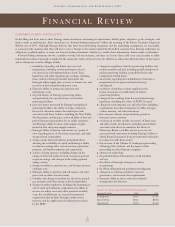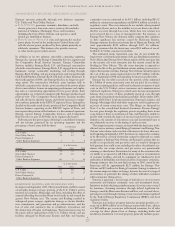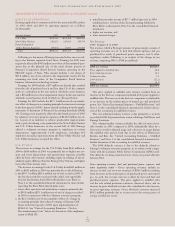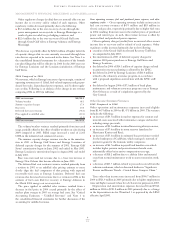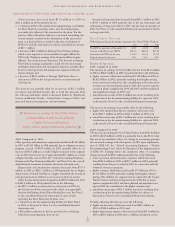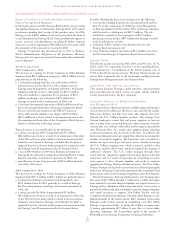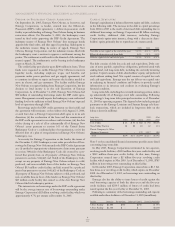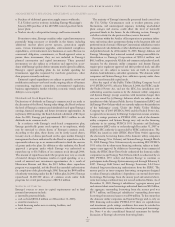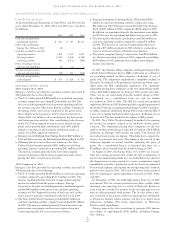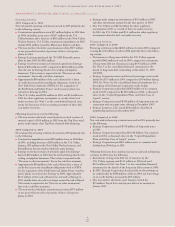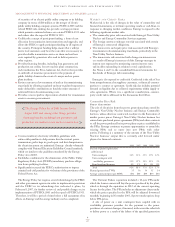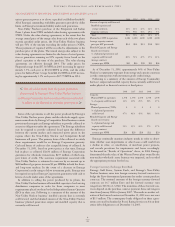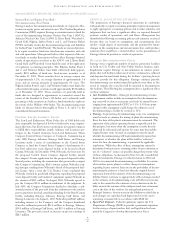Entergy 2005 Annual Report Download - page 44
Download and view the complete annual report
Please find page 44 of the 2005 Entergy annual report below. You can navigate through the pages in the report by either clicking on the pages listed below, or by using the keyword search tool below to find specific information within the annual report.
ENTERGY CORPORATION AND SUBSIDIARIES 2005
*
40
■Purchase of additional generation supply sources within the
U.S. Utility’s service territory, including Entergy Mississippi’s
January 2006 purchase of the 480 MW, natural gas-fired Attala
power plant.
■Nuclear site dry cask spent fuel storage and license renewals.
From time to time, Entergy considers other capital investments as
potentially being necessary or desirable in the future, including
additional nuclear plant power uprates, generation supply
assets, various transmission upgrades, environmental compliance
expenditures, or investments in new businesses or assets. Because no
contractual obligation, commitment, or Board-approval exists to
pursue these investments, they are not included in Entergy’s
planned construction and capital investments. These potential
investments are also subject to evaluation and approval in accor-
dance with Entergy’s policies before amounts may be spent. In addition,
Entergy’s capital spending plans do not include spending for
transmission upgrades requested by merchant generators, other
than projects currently underway.
Estimated capital expenditures are subject to periodic review and
modification and may vary based on the ongoing effects of business
restructuring, regulatory constraints, environmental regulations,
business opportunities, market volatility, economic trends, and the
ability to access capital.
Dividends and Stock Repurchases
Declarations of dividends on Entergy’s common stock are made at
the discretion of the Board. Among other things, the Board evaluates
the level of Entergy’s common stock dividends based upon Entergy’s
earnings, financial strength, and future investment opportunities. At
its January 2006 meeting, the Board declared a dividend of $0.54 per
share. In 2005, Entergy paid approximately $453.5 million in cash
dividends on its common stock.
In accordance with Entergy’s stock-based compensation plan,
Entergy periodically grants stock options to its employees, which
may be exercised to obtain shares of Entergy’s common stock.
According to the plan, these shares can be newly issued shares,
treasury stock, or shares purchased on the open market. Entergy’s
management has been authorized by the Board to repurchase on the
open market shares up to an amount sufficient to fund the exercise
of grants under the plans. In addition to this authority, the Board
approved a program under which Entergy was authorized to
repurchase up to $1.5 billion of its common stock through 2006.
The amount of repurchases under the program may vary as a result
of material changes in business results or capital spending, or as a
result of material new investment opportunities. As a result of
Hurricanes Katrina and Rita, the $1.5 billion share repurchase
program was suspended, and the Board has extended authorization
for completion of the plan through 2008. Entergy has $400 million
of authority remaining under the $1.5 billion plan. In 2005, Entergy
repurchased 12,280,500 shares of common stock under both
programs for a total purchase price of $878.2 million.
SOURCES OF CAPITAL
Entergy’s sources to meet its capital requirements and to fund
potential investments include:
■internally generated funds;
■cash on hand ($582.8 million as of December 31, 2005);
■securities issuances;
■bank financing under new or existing facilities; and
■sales of assets.
The majority of Entergy’s internally generated funds come from
the U.S. Utility. Circumstances such as weather patterns, price
fluctuations, and unanticipated expenses, including unscheduled
plant outages and storms, could affect the level of internally
generated funds in the future. In the following section, Entergy’s
cash flow activity for the previous three years is discussed.
Provisions within the Articles of Incorporation or pertinent inden-
tures and various other agreements relating to the long-term debt and
preferred stock of certain of Entergy Corporation’s subsidiaries restrict
the payment of cash dividends or other distributions on their common
and preferred stock. As of December 31, 2005, Entergy Arkansas and
Entergy Mississippi had restricted retained earnings unavailable for
distribution to Entergy Corporation of $396.4 million and
$68.5 million, respectively. All debt and common and preferred stock
issuances by the domestic utility companies and System Energy
require prior regulatory approval and their preferred stock and debt
issuances are also subject to issuance tests set forth in corporate
charters, bond indentures, and other agreements. The domestic utility
companies and System Energy have sufficient capacity under these
tests to meet foreseeable capital needs.
After the repeal of the Public Utility Holding Company Act of
1935 (PUHCA 1935), effective February 8, 2006, the FERC, under
the Federal Power Act, and not the SEC, has jurisdiction over
authorizing securities issuances by the domestic utility companies
and System Energy (except securities with maturities longer than
one year issued by (a) Entergy Arkansas which are subject to the
jurisdiction of the Arkansas Public Service Commission (APSC) and
(b) Entergy New Orleans which are currently subject to the jurisdiction
of the bankruptcy court). Under the Public Utility Holding
Company Act of 2005 (PUHCA 2005) and the Federal Power Act,
no approvals are necessary for Entergy Corporation to issue securities.
Under a savings provision in PUHCA 2005, each of the domestic
utility companies and System Energy may rely on the financing
authority in its existing PUHCA 1935 Securities and Exchange
Commission (SEC) order or orders through December 31, 2007 or
until the SEC authority is superceded by FERC authorization. The
FERC has issued an order (FERC Short-Term Order) approving
the short-term borrowing limits of the domestic utility companies
(except Entergy New Orleans) and System Energy through March
31, 2008. Entergy New Orleans may rely on existing SEC PUHCA
1935 orders for its short-term financing authority, subject to bank-
ruptcy court approval. In addition to borrowings from commercial
banks, the FERC Short-Term Order authorized the domestic utility
companies (except Entergy New Orleans which is authorized by an
SEC PUHCA 1935 order) and System Energy to continue as
participants in the Entergy System money pool through February 8,
2007. Entergy Gulf States and Entergy Louisiana, LLC have
obtained long-term financing authorization from the FERC. The
money pool is an inter-company borrowing arrangement designed
to reduce Entergy’s subsidiaries’ dependence on external short-term
borrowings. Borrowings from the money pool and external short-
term borrowings combined may not exceed authorized limits. As of
December 31, 2005, Entergy’s subsidiaries’ aggregate money pool
and external short-term borrowings authorized limit was $2.0 billion,
the aggregate outstanding borrowing from the money pool was
$379.7 million, and Entergy’s subsidiaries’ outstanding short-term
borrowing from external sources was $40 million. To the extent that
the domestic utility companies and System Energy wish to rely on
SEC financing orders under PUHCA 1935 there are capitalization
and investment grade ratings conditions that must be satisfied in
connection with security issuances, other than money pool borrowings.
See Note 4 to the consolidated financial statements for further
discussion of Entergy’s short-term borrowing limits.
MANAGEMENT’S FINANCIAL DISCUSSION and ANALYSIS continued


